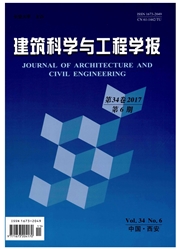

 中文摘要:
中文摘要:
采用有限元软件ANSYS对大跨度压型钢板-混凝土组合楼盖模型进行数值分析,研究楼板厚度与固有频率、峰值加速度之间的关系,并给出了满足舒适度要求的板厚建议公式。结果表明:现有规范对于人行荷载的简化忽略了人-板耦合等不利因素,使得峰值加速度计算结果偏小,人行激励模型应当考虑多阶简谐激励、作用位置变化以及人与楼盖相互作用;随着板厚的增加,刚度和质量对于楼盖体系固有频率的影响有一个临界点使固有频率取最小值,一味增加次梁数目到后期往往事倍功半;通过改变结构体系的布置来满足舒适度要求往往比改变板厚更为高效、经济;由于单人行走过程中楼板峰值加速度持续时间短,以均方根加速度作为评价指标更加合适。
 英文摘要:
英文摘要:
Numerical analysis on large-span profiled steel sheeting-concrete composite floor was carried to study the relationship of slab thickness, natural frequency and peak acceleration by finite element software ANSYS, and the suggested formula of slab thickness meeting the requirement of serviceability was given. The result shows that the peak acceleration calculated values according to the current code are underestimated, because the unfavorable factors of person-slab coupling are ignored due to the simplification of pedestrian load. Thus, the multi- order harmonic excitation effect and the change of pedestrian position, as well as the interaction between human and floor should be taken into consideration in the human-induced model. As the slab thickness rises, there is a critical value for getting the minimum frequency to balance the effect of stiffness and mass. Increasing the number of secondary beams on blind faith may not lead to a better result to solve the problem of serviceability, and changing the layout may be more efficient and economic than changing slab thickness. As the duration time of peak acceleration of slab is too short during single walking, taking weighted root mean square acceleration as evaluating indicator may be more suitable.
 同期刊论文项目
同期刊论文项目
 同项目期刊论文
同项目期刊论文
 期刊信息
期刊信息
